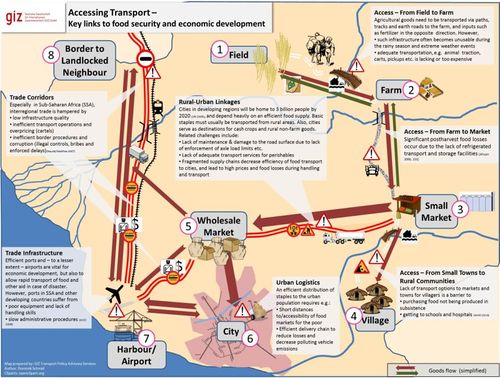Knowledge fuels change - Support energypedia!
For over 10 years, energypedia has been connecting energy experts around the world — helping them share knowledge, learn from each other, and accelerate the global energy transition.
Today, we ask for your support to keep this platform free and accessible to all.
Even a small contribution makes a big difference! If just 10–20% of our 60,000+ monthly visitors donated the equivalent of a cup of coffee — €5 — Energypedia would be fully funded for a whole year.
Is the knowledge you’ve gained through Energypedia this year worth €5 or more?
Your donation keeps the platform running, helps us create new knowledge products, and contributes directly to achieving SDG 7.
Thank you for your support, your donation, big or small, truly matters!
Access to Transport
Overview
Social and economic development in rural areas depends on many aspects - the access to transport and transportation services is surely a very significant one. The following article focuses on the importance of transport for rural development regarding its consequences on trade, agricultural production and accessibility of the population.
Mobility and Rural Development
Many factors drive economic and social development in rural areas. A factor that is invariably crucial is the access of people living in rural areas to transport infrastructure and services. Without transport, goods and services cannot be brought in sufficient quantity to the people who need them, agricultural products cannot be taken to market, children cannot attend school and those in need of medical attention cannot get to the nearest clinic. A diverse and vibrant exchange between rural areas and conurbations also depends on an effective transport system, as does participation in political and social life. Evaluating the part played by transport in rural development requires a broad perspective that does not merely focus on the rural road network and the accessibility of local markets and basic services but in addition considers the trans-regional links, including import and export corridors and hubs, that are also important for economic development.
The links between mobility and rural development will be explained more thoroughly within the following articles
1. Access to Basic Services and Accessibility of the Population
2. Economic perspective
2.1 The Perspective of Agricultural production: Access to Inputs and Markets
2.2 Rural-Urban-Linkages
2.3 The Role of Trade in Marketing Rural Products
3. The Environment and Safety: Adverse Effects of Transport Infrastructure
Options for further engagement of the international development cooperation is covered in the following part:
1. Promoting Rural Development through Mobility
Within the planning process an intensive cooperation between the sectors of transportation and rural development is required. The experience of numerous rural road-building projects has shown that, regrettably, close coordination between transport and rural development experts is rare. Transport promotion measures are not always integrated into the context of spatial or territorial development planning or social infrastructure. Integrated planning of investment in rural development also needs to give greater weight to the medium- and long-term challenges. In the case of infrastructure measures, it is particularly important to consider how maintenance is to be financed.In addition, the likely effects of climate change need to be taken into account in connection with both road building and maintenance.[1]
The following picture gives an overview about the key links between access to transport and rural economic development and food security.
In the following, a few regional examples for a clearer view:
Access - From Farm to Market:
In India, at least 50% of the production of fruits and vegetables is lost due to wastage and value destruction, with lack of adequate transport being one among the multiple causes. Annual costs estimated at 5 billion US$ .(Ahsan 2006, 133)
Access - From Small Villages to Rural Towns:
More than 900m People worldwide lack access to all-weather roads. The risk of death during giving birth is 36 times higher for women in developing countries, not least to the lack of access to medical treatment (WHO 2010)
Trade Infrastructure:
Average costs for container handling (ship-to-gate) in East Africa are US$135–275, compared to only US$80–154 in the rest of the world (AICD 2008)
Trade Corridors:
29 % of total transport costs for getting a truck load of onions from Madaoua, Niger to Accra, Ghana are caused by corruption (Bromley et al 2011)
Landlocked countries in Africa may lose the equivalent of up to 40% of the export on high transport costs (Naudé/Matthee 2007)[2]
Further Information
Further information on Transport and Rural Development:
- Transport Division (TD) & Asian Institute of Transport Development (2000): Impact of Rural Infrastructure Investment. – In: Evaluation of Infrastructural Interventions for Rural Poverty Alleviation. – pp. 29-44: www.unescap.org
- Faiz, A. (2012): The Promise of Rural Roads - Review of the Role of Low-Volume Roads in Rural Connectivity, Poverty Reduction, Crisis Management, and Livability. – The Transportation Research Circular. – No. E-C167. – Washington. www.trb.org
- White, P. (2011): Equitable Access - Remote and Rural Communities Transport Needs. – International Transport Forum. – Discussion Paper 2011-19.www.internationaltransportforum.org
Further information on Transport and Poverty Reduction:
- ILO (2008): Rural Transport, Poverty Reduction and Livelihood Improvement in the Lao PDR. – A Background Paper for Participants of the National Workshop:www.ilo.org
- Setboonsarng, S. (2008): The Impact of Rural Infrastructure and Agricultural Support Services on Poverty: The Case of Agrarian Reform Communities in the Philippines. – ADB Institute Discussion Paper No. 110. – Japanwww.adbi.org
References
- ↑ Schmid, D.; Bartholdi, M.; Moosmann, K; Czeh, A.; Engelskirchen, M.(2013): Improving the Accessibility of Rural Areas – The Contribution of Transport to Rural Development . Eschborn, Germany: GIZ GmbH (Deutsche Gesellschaft für Internationale Zusammenarbeit) and KfW Bankengruppe.
- ↑ Machbarkeitsstudie zum Thema Verkehr in der deutschen Entwicklungszusammenarbeit, im Auftrag des BMZ, GIZ 2013, unveröffentlicht.




















